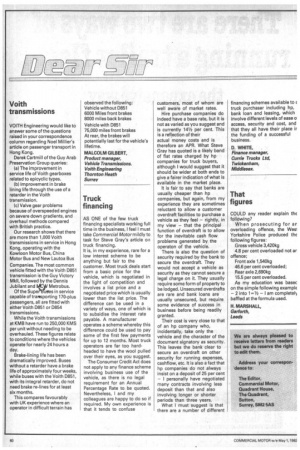Voith transmissions
Page 52

If you've noticed an error in this article please click here to report it so we can fix it.
VOITH Engineering would like to answer some of the questions raised in your correspondence column regarding Noel Millier's article on passenger transport in Hong Kong.
Derek Cartmill of the Guy Arab Preservation Group queries: (a) The improvement in service life of Voith gearboxes related to epicyclic types.
(b) Improvement in brake lining life through the use of a retarder in the Voith transmission.
(c) Valve gear problems because of overspeeded engines on severe down gradients, and overhaul methods compared with British practice.
Our research shows that there are more than 1,000 Voith transmissions in service in Hong Kong, operating with the Kowloon Motor Bus, China Motor Bus and New Lautoa Bus
Companies. The most common vehicle fitted with the Voith D851 transmission is the Guy Victory MkII, followed by the Dennis Jubilant and alcyl Metrobus.
Of the Supenles in service capable of transporting 170-plus passengers, all are fitted with either Voith D851 or D854 transmissions.
While the Voith transmissions at KMB have run to 250,000 KMS per unit without needing to be overhauled. These figures relate to conditions where the vehicles operate for nearly 24 hours a day.
Brake-lining life has been dramatically improved. Buses without a retarder have a brake life of approximately four weeks, while buses with the Voith D851, with its integral retarder, do not need brake re-lines for at least six months.
This compares favourably with UK experience where an operator in difficult terrain has observed the following: Vehicle without D851 6000 Miles front brakes 8000 miles back brakes Vehicle with D851 75,000 miles front brakes At rear, the brakes will potentially last for the vehicle's lifetime.
MALCOLM GILBERT, Product manager, Vehicle Transmissions.
Voith Engineering Thornton Heath Surrey
Truck financing
AS ONE of the few truck financing specialists working full time in the business, I feel I must take Commercial Motor mildly to task for Steve Gray's article on truck financing.
It is, in my experience, rare for a low interest scheme to be anything but fair to the customer. Most truck deals start from a basic price for the vehicle, which is negotiated in the light of competition and involves a list price and a negotiated price which is usually lower than the list price. The difference can be used in a variety of ways, one of which is to subsidise the interest rate payable. A manufacturer operates a scheme whereby this difference could be used to pay some of the first few payments for up to 12 months. Most truck operators are far too hardheaded to have the wool pulled over their eyes, as you suggest.
The Consumer Credit Act does not apply to any finance scheme involving business use of the vehicle, as there is no legal requirement for an Annual Percentage Rate to be quoted. Nevertheless, I and my colleagues are happy to do so if required. My own experience is that it tends to confuse customers, most of whom are well aware of market rates.
Hire purchase companies do indeed have a base rate, but it is not as varied as you suggest and is currently 141/2 per cent. This is a reflection of their
actual money costs and is therefore an APR. What Steve • Gray has quoted is a likely band of flat rates charged by hp companies for truck buyers, although I would suggest that it should be wider at both ends to give a fairer indication of what is available in the market place.
It is fair to say that banks are usually cheaper than hp companies, but again, from my experience they are sometimes reluctant to allow a customer overdraft facilities to purchase a vehicle as they feel — rightly, in my view — that the principal function of overdraft is to allow for the inevitable cash flow problems generated by the operaton of the vehicle.
There is also the question of security required by the bank to secure the overdraft. They would not accept a vehicle as security as they cannot secure a legal charge on it. They usually require some form of property to be lodged. Unsecured overdrafts are rare and bank loans are usually unsecured, but require some evidence of success in business before being readily granted.
Their cost is very close to that of an hp company who, incidentally, take only the vehicle and the character of the document signatory as security. This leaves the bank clear to secure an overdraft on other security for running expenses, cashflow, etc. It is also a fact that hp companies do not always insist on a deposit of 25 per cent — I personally have negotiated many contracts involving less deposit than that and also involving longer or shorter periods than three years.
What I must suggest is that there are a number of different financing schemes available to t' truck purchaser including hp, bank loan and leasing, which involve different levels of ease o access, security and cost, and that they all have their place ir the funding of a successful business.
O. WHITE, Finance manager, Currie Trucks Ltd, Twickenham, Middlesex.
That figures
COULD any reader explain thE following?
When prosecuting for ar overloading offence, the West Yorkshire Police produced thE following figures: Gross vehicle 3,420kg 4.8 per cent overloaded not ar offence; Front axle 1,540kg 46.6 per cent overloaded; Rear axle 2,690kg 15.5 per cent overloaded.
As my education was basec on the simple following examplE —2 into 1=1/2 — I am completeIN baffled at the formula used.
H. MARSHALL, Garforth, Leeds




































































